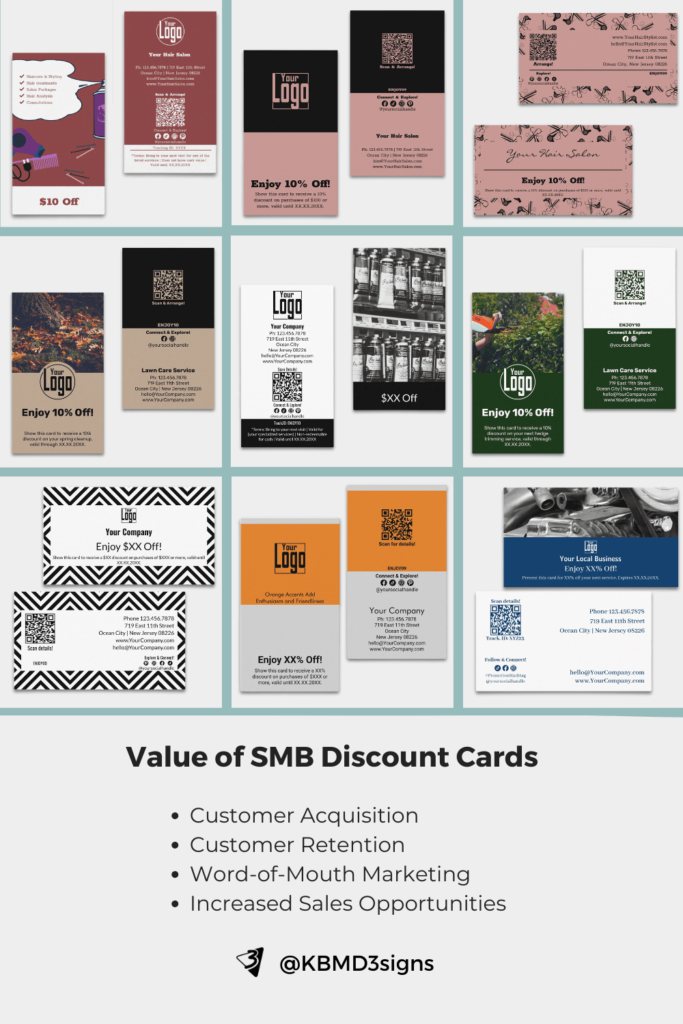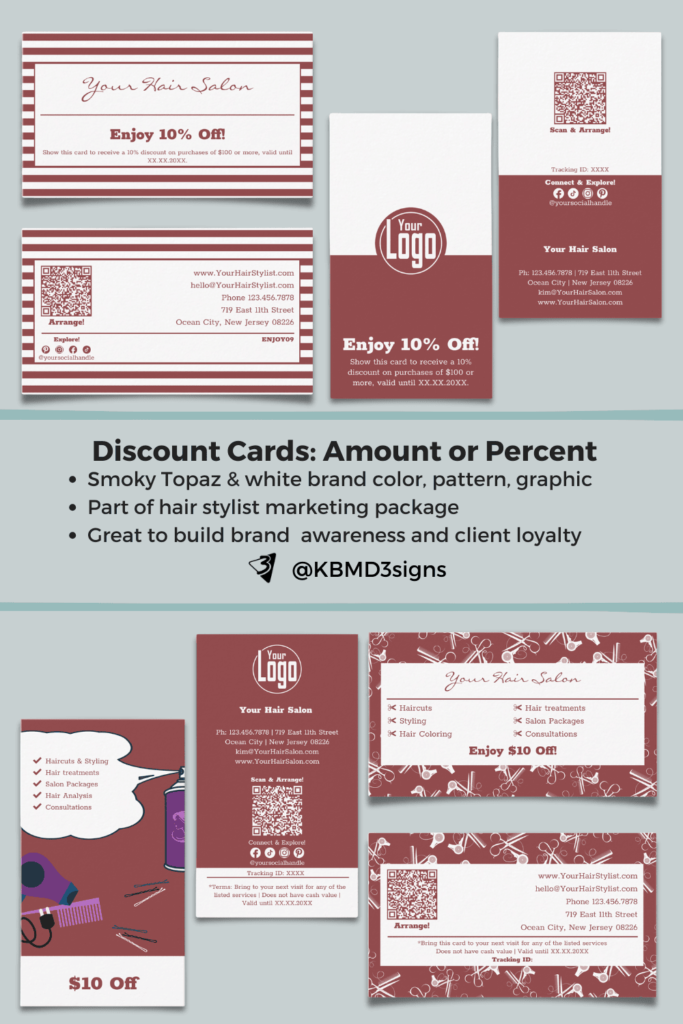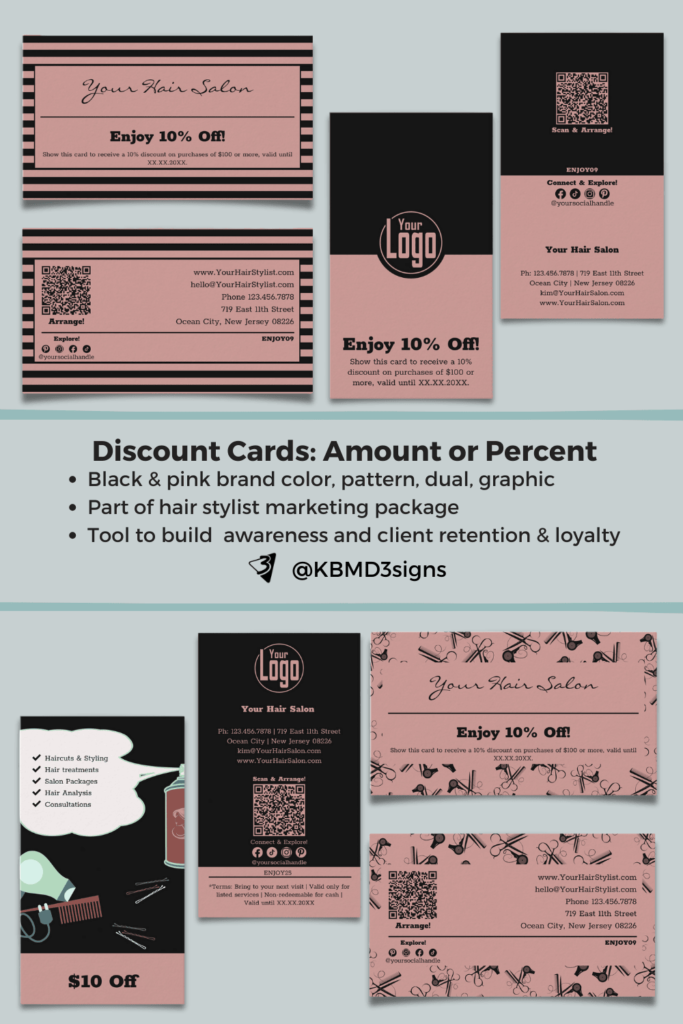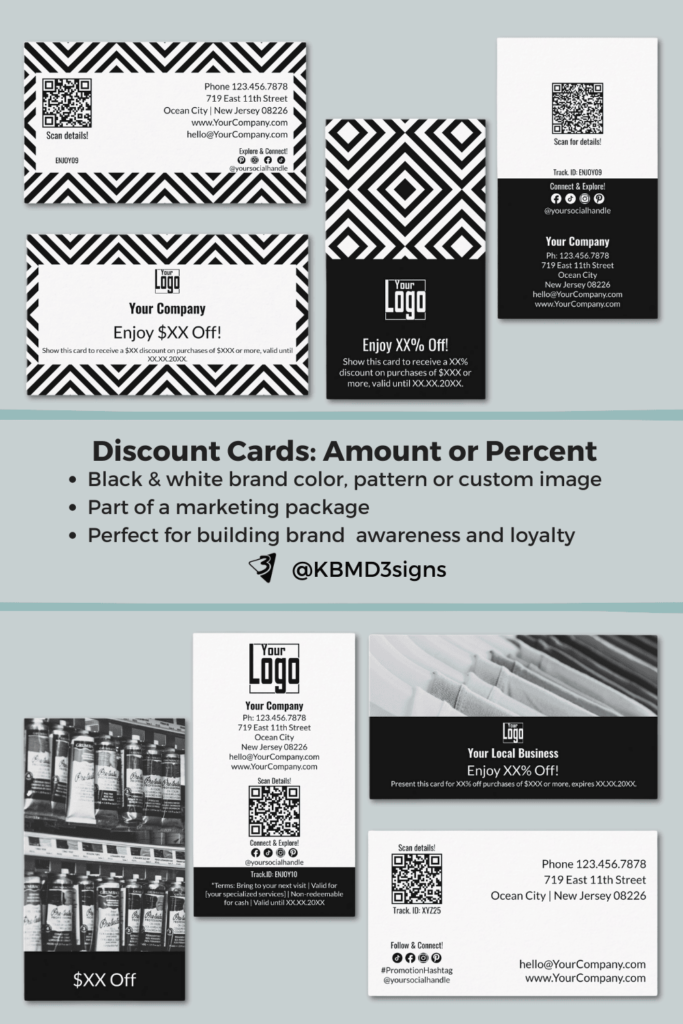For small service businesses, discount cards are a powerful offline marketing tool to attract new customers, retain existing ones, and foster loyalty. These cards act as a direct incentive, motivating potential clients to choose your services over competitors. Let’s explore the benefits, essential information, and design considerations for discount cards in small service businesses.
Article content:
- The Value of Discount Cards
- How Small Businesses Benefit from Discount Cards
- Discount Card Design Examples by KBM D3signs
- Information to Include on Discount Cards
- Sizing and Design for Discount Cards
- Types of Discount Cards for Small Service Businesses
- Using Discount Cards in Offline Marketing
- What is the difference between a voucher and a discount card?
- FAQs About Discount Cards for Small Service Businesses
1. The Value of Discount Cards
Discount cards serve as a cost-effective promotional tool for businesses like hair salons, spas, fitness centers, and other personal service providers. By offering a tangible discount, these cards provide customers with an immediate, clear benefit, encouraging them to try your service or return for more.
2. How Small Businesses Benefit from Discount Cards
- Customer Acquisition: A first-time customer is more likely to try a new service if they have a discount incentive.
- Customer Retention: Rewarding repeat visits with a discount encourages loyalty and more frequent use of services.
- Word-of-Mouth Marketing: Satisfied clients who receive a discount are more likely to refer friends or family.
- Increased Sales Opportunities: Discount cards encourage upselling and cross-selling of additional services.
Discount Card Design Examples by KBM D3signs
Our commitment to our mission is reflected in our exceptional discount cards designed by KBM D3signs. We strive to simplify the customization process by offering easily customizable templates within our marketing packages. Using the templates allows for the customization of all text and images, as well as the customization of QR code details where applicable.
Part of the:
Smoky Topaz Hair Salon Biz Cards & Marketing Items Collection
Black Pink Hair Stylist Business Cards & Suite collection
Black & White Business Card Designs & Materials Collection
But the customization possibilities for discount cards go even further. Our belief is rooted in the idea that everyone should have the freedom to choose their preferred colors for a selected design, ensuring that it perfectly matches your vision and needs.
At the Cocoon It! Store by KBM D3signs on Zazzle puts all the branding elements and color schemes in your hands. Whether you’re choosing products with a QR code – where the second color is limited to black or white for optimal contrast – or exploring the vast array of customizable elements through the “Edit Further” link, your brand’s unique identity is yours to define.
We use these color tools. They can help you choose the perfect hues, and for additional inspiration, explore our curated collection of color palette ideas. Our commitment to customization goes beyond placeholders-almost all elements can be customized to match your chosen colors.
If you need additional assistance customizing or transferring designs to different products, or if you have a unique vision that requires a custom design, we are just a message away. At Designs by KBM D3signs, we go beyond providing marketing materials; we empower you to shape and showcase your brand with creativity and personalization.
Shop at Zazzle Store
Cocoon It! – Discount Cards
Show off your personal style or post a review!
4. Information to Include on Discount Cards
Discount cards need to be visually appealing and provide the right information to be effective. Here are the essential elements every discount card should include:
- Business Name and Logo: Your brand should be easily recognizable. Place your logo prominently at the top or center.
- Discount Offer: Clearly state the discount percentage or amount (e.g., “10% Off” or “$5 Off Your Next Visit”).
- Services Applicable: Specify which services are covered under the offer, whether it’s for a particular service or a general discount.
- Expiry Date: A clear expiration date creates urgency and motivates customers to use the discount within a limited timeframe.
- Terms and Conditions: Include any conditions, such as a minimum purchase requirement or whether the discount can be combined with other offers.
- Contact Information: Add your business address, phone number, website, and/or QR code for easy access to your services or booking system.
- Tracking Code (Optional): A tracking number helps monitor the success of the discount card campaign.
5. Sizing and Design for Discount Cards
Discount cards are typically designed to be compact, making them easy to carry in wallets or purses. The most common size is 3.5″ x 2″ (standard business card size). This size is convenient for distribution and ensures the card can be carried without hassle.
Design Tips for Discount Cards:
- Brand Consistency: Use your brand’s color palette, fonts, and style to ensure the card aligns with your overall branding.
- Readable Fonts: Choose fonts that are easy to read, even on a small card. Avoid overly decorative fonts for essential information like the discount amount or expiry date.
- Eye-Catching Visuals: Incorporate appealing imagery or simple icons that represent your services without overwhelming the card.
- High-Quality Printing: Opt for durable materials and high-resolution printing to give the card a professional feel, reflecting the quality of your services.
6. Types of Discount Cards for Small Service Businesses
Different types of discount cards can be employed based on the marketing strategy and business needs. Here are a few common options:
- Percentage-Based Discounts: Offering 10%, 15%, or 20% off encourages first-time customers to try your service. These are great for drawing in new clients.
- Flat-Amount Discounts: A discount of $10 or $20 off is a straightforward way to appeal to cost-conscious customers. Flat discounts work particularly well with service packages or high-ticket services.
- Buy X, Get Y Discounts: Offering a discount after multiple visits or purchases (e.g., “Get a Free Service After 5 Visits”) encourages long-term engagement and loyalty.
- Seasonal or Event-Specific Discounts: Time-limited offers during holidays or seasonal events (e.g., “Valentine’s Day Special” or “New Year New Look”) entice customers to use your services during key periods.
7. Using Discount Cards in Offline Marketing
Offline marketing strategies like handing out discount cards at events, within the local community, or inside your store can create a personal connection. Encourage customers to distribute the cards to friends and family, further expanding your reach.
- In-Store Display: Place discount cards at checkout counters, reception desks, or in-service stations for easy access.
- Local Partnerships: Team up with local businesses to distribute your discount cards in their stores or services, and vice versa.
- Event Distribution: Hand out discount cards at local events, fairs, or community gatherings to introduce your brand to a broader audience.
Overall, for small service businesses, discount cards are a simple yet highly effective way to enhance offline marketing, attract new customers, and reward loyal clients. By offering a direct incentive, ensuring a professional design, and distributing them strategically, discount cards can have a lasting impact on your business growth. Consider implementing a discount card campaign and watch your customer base grow.
8. What is the Difference Between a Discount Card and a Voucher?
The key difference between a voucher and a discount card lies in their purpose and how they are used. Both can be valuable tools in offline marketing for small businesses, but they serve different functions. Here’s a breakdown:
Voucher
- Purpose: A voucher represents a specific value or service that can be redeemed. It is typically used like cash for a particular product, service, or set of offerings at a business.
- Type: Can be a gift voucher, bought by one person and given to another, or a promotional voucher, distributed by the business to encourage customers to try their services.
- Redemption: When used, the full value of the voucher is usually redeemed in exchange for the specified product or service.
- Format: Vouchers are often one-time use and may come in paper or digital format.
- Example: A customer purchases a $50 haircut voucher, which can be redeemed for that service.
Discount Card
- Purpose: A discount card offers a percentage or set amount off a purchase, allowing the holder to receive a discount on products or services.
- Type: It may be a loyalty card, membership card, or promotional card that gives the customer ongoing or one-time discounts.
- Redemption: Rather than redeeming a full value, the discount card applies a reduction to the total price. It often doesn’t cover the entire cost but lowers it.
- Format: Discount cards can be reusable over multiple transactions (e.g., 10% off each purchase) or for a limited time (e.g., a coupon card valid for one month).
- Example: A customer has a discount card that gives them 10% off every visit to a salon for three months.
Summary of Key Differences:
- Value vs. Discount:
Vouchers are redeemed for their full value or specific service (like a haircut or spa treatment).
Discount cards reduce the price of a service or product but don’t cover the entire amount. - One-Time vs. Reusable:
Vouchers are usually one-time use—once redeemed, the voucher is spent.
Discount cards can be reusable, allowing for discounts on multiple purchases. - Gifting vs. Incentivizing:
Vouchers are often given as gifts or promotional tools to bring in new clients.
Discount cards are typically used as loyalty tools to encourage repeat business by offering ongoing savings.
Example in Small Business Marketing:
- Voucher: A salon might sell a $100 gift voucher for services, which can be redeemed by the recipient for any service up to that value.
- Discount Card: The same salon might issue a discount card offering 10% off on all services for three months to loyal customers, encouraging them to return more often.
Each has its place in marketing strategies, with vouchers targeting new customers (or gifts) and discount cards focusing on building customer loyalty.
-

6 Winter Marketing Ideas for Small Businesses
Read the post …: 6 Winter Marketing Ideas for Small Businesses -

6 Offline Summer Marketing Ideas for Small Businesses
Read the post …: 6 Offline Summer Marketing Ideas for Small Businesses -

What is Seasonal Marketing? A Guide for Small Business Offline Success
Read the post …: What is Seasonal Marketing? A Guide for Small Business Offline Success
9. FAQs About Discount Cards for Small Service Businesses
A discount card is a physical card that offers a specific discount or promotion on your services. It benefits small businesses by:
・ Attracting new customers
・ Encouraging repeat visits
・ Promoting customer loyalty
・ Generating word-of-mouth referrals
・ Increasing sales by incentivizing customers to spend more.
Common discount types include:
・ Percentage discounts (e.g., 10% off any service)
・ Flat-rate discounts (e.g., $10 off a purchase)
・ Buy X, Get Y free (e.g., buy five services, get one free)
・ Seasonal or event-specific discounts (e.g., 20% off during the holiday season).
The standard size for a discount card is 3.5″ x 2″, which is the same as a business card. This size fits easily into wallets and is convenient for customers to carry around.
Your discount card should include:
・ Business name and logo
・ Discount offer (percentage or flat amount)
・ Applicable services
・ Expiration date
・ Terms and conditions
・ Contact information (phone, email, website, or QR code)
・ Optional: tracking code for monitoring effectiveness.
Yes, you can add a tracking code to your discount cards to monitor redemption and effectiveness. Some businesses even use punch cards, where customers get a discount or free service after a certain number of visits.
You can distribute discount cards in several ways:
・ At your store or business location
・ Through local partnerships with complementary businesses
・ At community events or fairs
・ With every purchase or service
・ In welcome packages for new customers
・ By mail or in local publications.
The expiry date depends on the promotion, but a 3–6 month validity is common. Shorter expiry dates create urgency, while longer ones provide flexibility for customers.
This depends on your business policy. Make sure to clearly state on the card whether the discount can be combined with other offers, or if it’s a stand-alone promotion. Including terms and conditions ensures there’s no confusion.
Focus on these design elements:
・ Brand consistency: Use your brand colors, fonts, and logo.
・ Readable fonts: Ensure discount details are clear and easy to read.
・ Appealing visuals: Use simple images or icons that reflect your services.
・ High-quality print: Use durable materials for a professional finish.
No, discount cards can be tailored for different purposes:
・ New customers: Offer an introductory discount to attract first-time clients.
・ Loyal customers: Provide discounts or special offers for repeat visits to retain existing customers.
・ Referral programs: Give customers cards they can share with friends and family for a discount on their first visit.
Track your discount card campaign by:
・ Using tracking codes or serial numbers on the cards
・ Monitoring the number of cards redeemed
・ Comparing sales data before and after the campaign
・ Gathering customer feedback on how they heard about your business.
Yes, many businesses are shifting to digital discount cards via email or mobile apps. These can be more convenient for customers and easier to track, but physical cards still have a tangible, personal appeal that resonates with many customers.
A discount card provides a one-time discount or promotional offer, while a loyalty card rewards repeat customers with discounts or free services after multiple visits. Both can boost customer retention but serve different marketing purposes.
Absolutely! Discount cards are a great way to introduce new services or products to your customers. Offering a limited-time discount creates excitement and encourages clients to try something new.
Provide exceptional service during the customer’s visit, and consider offering them a loyalty card or another promotion to encourage return visits.
-

What Is A Brand Partnership? – A Small Business Perspective
Read the post …: What Is A Brand Partnership? – A Small Business Perspective -
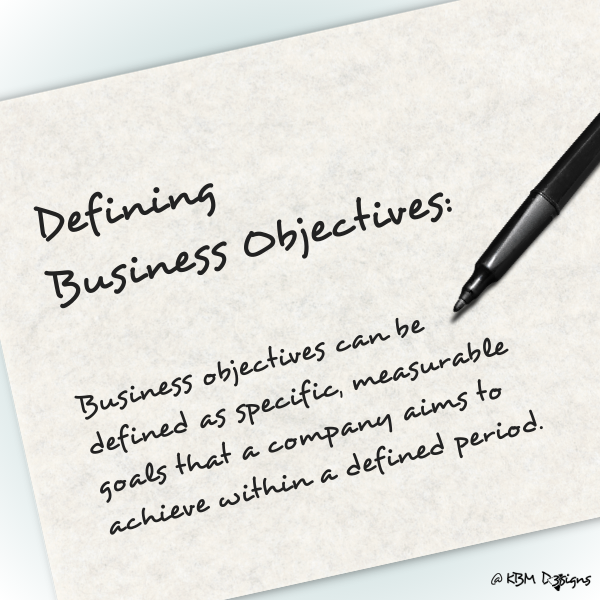
What Are Business Objectives?” Perspective Of A Small Business
Read the post …: What Are Business Objectives?” Perspective Of A Small Business -

What Is A Focus Group Market Research? – SMB Perspective
Read the post …: What Is A Focus Group Market Research? – SMB Perspective


